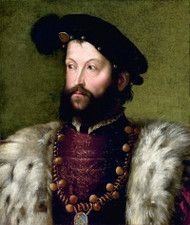Niccolo dell'Abate - 1509-1571
Published by Therese Myles on 20th Mar 2020
Nicollo dell'Abate was born in 1509 in Modena, Italy. Signore dell'Abate was most well known for his frescos and oil paintings, mostly done in a Mannerist style. Signore dell'Abate was trained under Antonio Begarelli, who was a local sculptor. Not much else is known of his early life, nor much until his career took off in 1537. Long friezes were the most common form that dell'Abate specialized in, although he also did frescoes. Many of Signore dell'Abate's works centered around mythical and secular beings. Some of his earlier works, starting in 1537, included work in the Palazzo dei Beccherie and Rocca at Scandiano. It is believed that his was the work removed from the Palazzo Casotti at Reggio Emilia.
Near 1538 and throughout the 1540's Signore dell'Abate did some work with fellow artist Alberto Fontana. Some of their work included building faces such as the Pratonieri Palace. One of his more famous works was called Concert and featured young musicians in a ring. In 1540 dell'Abate did scenes from the poet Virgil's Aeneid within a castle near Modena. The work that is thought to have established his reputation was the Martyrdom of Saint Peter and Saint Paul in the church of San Pietro in 1547. Also in 1547 Signore dell'Abate moved briefly to Bologna, where he met the artists Correggio and Parmigianino who are believed to have heavily influenced his style after that point.
Signore dell'Abate continued to work in and around Modena and Bologna until 1552 when he was called to the court of King Henry II of France to be an assistant to the painter Francesco Primaticcio. There he completed many works, though most were lost or destroyed after his death. Among the destroyed was his fresco upon the chapel ceiling of Hôtel de Guise which was made under Primaticcio's designs.
Signore dell'Abate would never see his Italia again, as he stayed in France, normally within the King's court at Fontainebleau, for the rest of his life. He painted many works for both King Henry II and later King Charles IX and ended up inspiring both Claude Lorrain and Nicolas Poussin, among others. Many of the easel works were eventually burned by Anna, the Austrian regent, in 1643. To the best of anyone's knowledge Signore dell'Abate had one son, Giulio Camillo. The final works it was believed dell'Abate ever made were with the help of his son, totaling sixteen different murals. His final works were done in 1571, while he died later in that same year.
The works that still survive can be found all over the world in different museums. Primarily they can be found throughout Italy and France, as that was where he was most influential. Some of his surviving works include: Baby Moses on the Water (1560), Portrait of a Young Man (1540), Rape of Persephone (1573), and the Chimney Breast at the Chateau d'Ecouen (1552).

